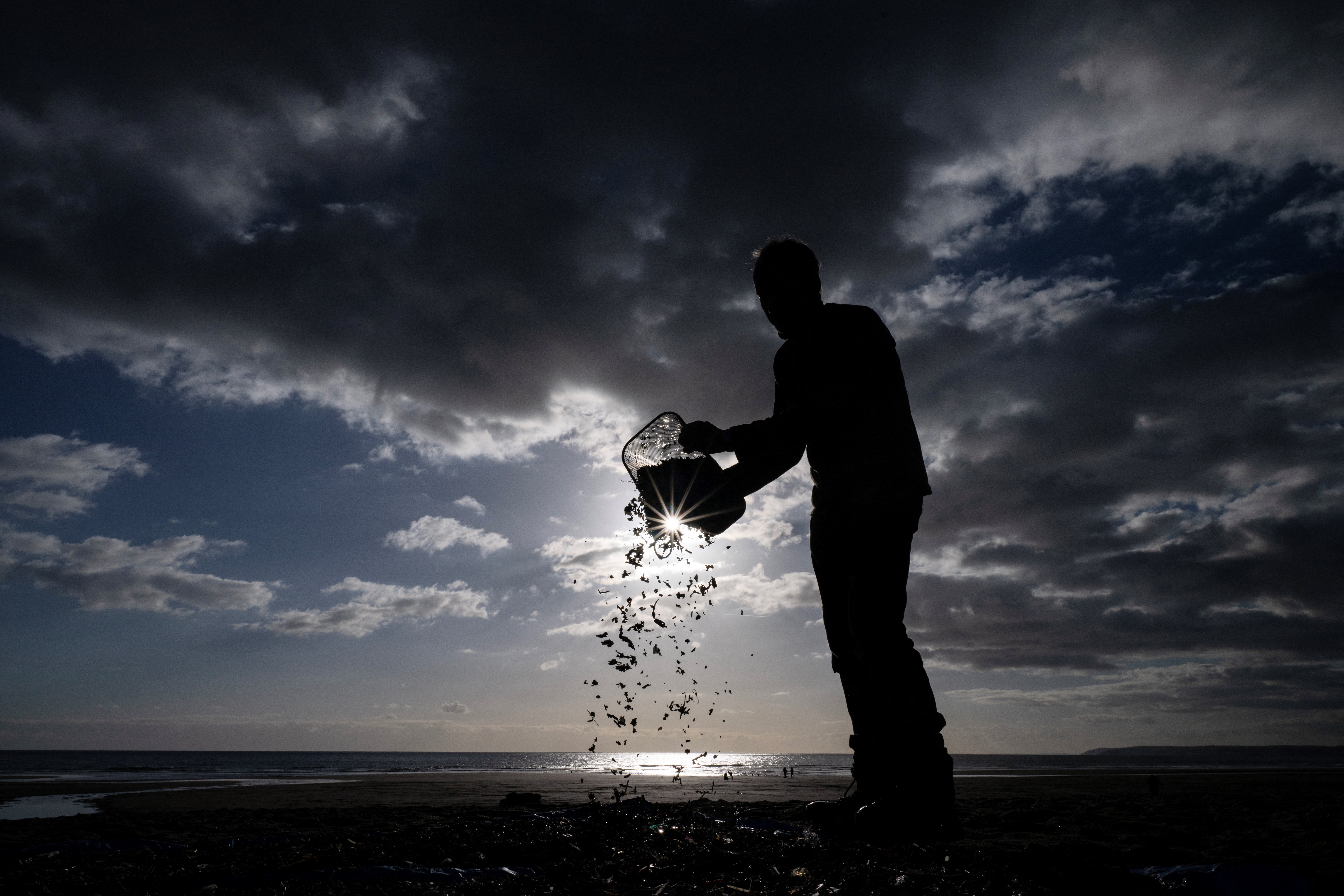Southeast Asia tops global intake of microplastics–study

A volunteer pours the contents of a bucket full of nurdles and microplastics onto a tarp during a beach clean on the Tregantle beach part of the Whitesand Bay, near Freathy, south western England, on February 26, 2023. FILE PHOTO/Agence France-Presse
SINGAPORE – Southeast Asian countries such as Malaysia, Indonesia and the Philippines ingest the most microplastics among 109 countries, according to a study by Cornell University researchers.
Indonesians, the top consumers of microplastics, were found to ingest about 15g of microplastics per month – equivalent to three credit cards – with the majority of plastic particles coming from aquatic sources such as fish and seafood.
Using existing data models, the study found that Indonesians’ daily consumption of microplastics increased by 59 times from 1990 to 2018, the date range used for the models.
READ: Microplastics: The nearly invisible poison in our oceans
Microplastics, defined as plastic particles smaller than 5mm, are fibers, fragments or granules created when plastic products break down, or can be shed by synthetic textiles. Accidental spills and improper handling of plastic pellets, the raw ingredients in plastic manufacturing, can cause them to enter the environment.
Article continues after this advertisementAs plastic consumption has increased in fast-growing developing countries such as Indonesia and Malaysia, common waste management methods, such as open dumping, are inadequate in handling the increasing volume of discarded plastics, resulting in more than 30,000 tonnes of mismanaged waste yearly, noted the paper’s authors.
Article continues after this advertisementWhen not managed properly, plastic from open dumping sites or landfills can be transported into nearby water bodies via rainwater.
Microplastics are commonly ingested by pytoplankton and zooplankton, which fish and aquatic animals feed on. And people are indirectly ingesting plastic when eating seafood.
READ: Microplastics: Why we now already breathe, ingest killer plastics
Microplastics can also be inhaled. The study, published in the journal Environmental Science & Technology on April 24, found that residents of China and Mongolia inhaled the most microplastics among the 109 countries studied, breathing in more than 2.8 million particles per month.
Dust-like airborne microplastics mainly originate from the abrasion of plastic materials, such as those in tyres, according to the study. Synthetic textiles can also release microplastics into the air during their production, or when they are washed or worn.
“Industrialization in developing economies, particularly in East and South Asia, has led to increased consumption of plastic materials, waste generation and human microplastic uptake,” said the study’s co-author Fengqi You, a professor in energy systems engineering at Cornell University
However, developed countries are seeing a reverse trend as they are supported by greater economic resources to reduce and remove plastic debris, he added.
Microplastics are now an environmental issue, plaguing even the deepest parts of the ocean and in the world’s highest mountain. They are also a growing health issue.
READ: In which countries are people eating and breathing the most microplastics?
Dr Lim Lee Guan, a gastroenterologist at Mount Elizabeth Hospital, said that studies in animals have shown that ingesting microplastics may have toxic effects on the lining of intestines, inducing inflammatory responses and causing intestinal swelling and ulcerations.
Consumption of microplastics also affects the diversity and composition of microorganisms that live inside the intestines, he said. And the disruption of balanced gut microbiome impedes the digestive and immune function of the gut.
However, Dr Lim noted that there is still limited evidence to prove microplastics are adversely impacting human health.
“Nevertheless, the consensus among all stakeholders is that plastics do not belong in the environment, and steps need to be taken to reduce exposure,” he said.
Currently, there is a growing body of work done to investigate the health effects of microplastics and nanoplastics – plastic particles under one micrometre or one-70th the width of a human hair, and small enough to enter the bloodstream and travel around the body.
A recent study published in the journal Toxicological Sciences on May 15 found microplastics and nanoplastics in human testicles, raising concerns about their possible effects on reproductive health.
The researchers from the University of New Mexico studied 47 canine and 23 human testicles and found microplastic pollution in every sample, with polyethylene, used in plastic bags and bottles, being the most prevalent plastic in both human and canine tissue.
The testicles were collected from autopsies of men aged 16 to 88 and from nearly 50 dogs after they were neutered at local veterinary clinics.
The sperm count in the dogs’ testicles was found to be lower when the testicles had higher contamination of polyvinyl chloride plastic. However, further research is needed to prove that microplastics cause sperm counts to fall.
Speaking in Parliament on April 3, Senior Minister of State for Sustainability and the Environment Amy Khor said that there is insufficient data to fully understand the impact of microplastics and nanoplastics on human health according to the World Health Organisation and Food and Agriculture Organisation of the United Nations.
Regardless, Singapore is closely monitoring international discussions and scientific studies on microplastics and nanoplastics.
Dr Khor added that measures have been implemented to reduce plastic waste and to minimize the plastic debris entering the environment.
These include robust waste management systems, a strict anti-littering enforcement regime, and measures to encourage businesses and individuals to reduce the consumption of single-use plastics.
Additionally, microplastics are removed at Newater and desalination plants in Singapore using reverse osmosis membranes.
During the treatment process, microplastics in used water are substantially removed as sludge and incinerated. The bulk of the treated used water is further processed and reclaimed as Newater. As a result of these processes, only a small amount of microplastics is discharged into the sea.